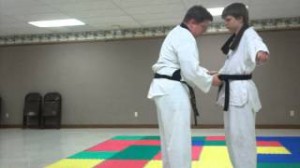La route de ceinture jaune
Quand j'ai commencé les arts martiaux avec une classe de karaté Shotokan de notre collège junior locale, l'instructeur a remis un article pour tout le monde à lire. L'article portait sur une étude des statistiques. L'étude a révélé que, sur chaque 10,000 étudiants en arts martiaux ne 100 irait à gagner ceintures noires. Most beginning students quit after six months and seventy-five percent quit after a year.
In the almost ten years that I have been teaching, I have found these statistics to be pretty accurate. Due the high attrition rate, I have begun to rethink what a modern curriculum should look like. If most students will be gone in six months and most students come to class to learn self-defense, we should focus the first six months of a student’s training on making them as “street ready” as possible.

Attribution “Trey” sa ceinture noire sur Avril 27, 2013.
In retrospect, I would make the beginner’s program six months long. We would focus on learning the techniques by striking pads, sparring and practicing self-defense. Once the student showed a significant mastery of these techniques, I would teach them the things that make a martial art: forms, traditional drills and traditional sparring.
Most martial arts programs including mine are very concerned about outlining the path for the student who wants to get their black belt. It is important to encourage and guide those rare students who will one day be black belts. Cependant, it is just as important if not more so to have a solid beginning program because most students don’t go past this level.
Pin It
